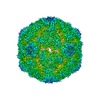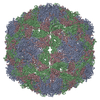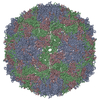+ Open data
Open data
- Basic information
Basic information
| Entry | Database: EMDB / ID: EMD-0565 | |||||||||||||||
|---|---|---|---|---|---|---|---|---|---|---|---|---|---|---|---|---|
| Title | Extracellular factors prime enterovirus particles for uncoating | |||||||||||||||
 Map data Map data | Echovirus 1 expanded particle sharpened map | |||||||||||||||
 Sample Sample |
| |||||||||||||||
 Keywords Keywords | expanded particle / VIRUS | |||||||||||||||
| Function / homology |  Function and homology information Function and homology informationcaveolin-mediated endocytosis of virus by host cell / symbiont-mediated suppression of host cytoplasmic pattern recognition receptor signaling pathway via inhibition of RIG-I activity / picornain 2A / symbiont-mediated suppression of host mRNA export from nucleus / symbiont genome entry into host cell via pore formation in plasma membrane / picornain 3C / T=pseudo3 icosahedral viral capsid / host cell cytoplasmic vesicle membrane / nucleoside-triphosphate phosphatase / channel activity ...caveolin-mediated endocytosis of virus by host cell / symbiont-mediated suppression of host cytoplasmic pattern recognition receptor signaling pathway via inhibition of RIG-I activity / picornain 2A / symbiont-mediated suppression of host mRNA export from nucleus / symbiont genome entry into host cell via pore formation in plasma membrane / picornain 3C / T=pseudo3 icosahedral viral capsid / host cell cytoplasmic vesicle membrane / nucleoside-triphosphate phosphatase / channel activity / monoatomic ion transmembrane transport / DNA replication / RNA helicase activity / symbiont-mediated activation of host autophagy / RNA-directed RNA polymerase / cysteine-type endopeptidase activity / viral RNA genome replication / RNA-directed RNA polymerase activity / DNA-templated transcription / virion attachment to host cell / host cell nucleus / structural molecule activity / ATP hydrolysis activity / proteolysis / RNA binding / zinc ion binding / ATP binding / membrane Similarity search - Function | |||||||||||||||
| Biological species |  Echovirus E1 Echovirus E1 | |||||||||||||||
| Method | single particle reconstruction / cryo EM / Resolution: 3.6 Å | |||||||||||||||
 Authors Authors | Domanska A / Ruokolainen V | |||||||||||||||
| Funding support |  Finland, 4 items Finland, 4 items
| |||||||||||||||
 Citation Citation |  Journal: J Virol / Year: 2019 Journal: J Virol / Year: 2019Title: Extracellular Albumin and Endosomal Ions Prime Enterovirus Particles for Uncoating That Can Be Prevented by Fatty Acid Saturation. Authors: Visa Ruokolainen / Aušra Domanska / Mira Laajala / Maria Pelliccia / Sarah J Butcher / Varpu Marjomäki /   Abstract: There is limited information about the molecular triggers leading to the uncoating of enteroviruses under physiological conditions. Using real-time spectroscopy and sucrose gradients with ...There is limited information about the molecular triggers leading to the uncoating of enteroviruses under physiological conditions. Using real-time spectroscopy and sucrose gradients with radioactively labeled virus, we show at 37°C, the formation of albumin-triggered, metastable uncoating intermediate of echovirus 1 without receptor engagement. This conversion was blocked by saturating the albumin with fatty acids. High potassium but low sodium and calcium concentrations, mimicking the endosomal environment, also induced the formation of a metastable uncoating intermediate of echovirus 1. Together, these factors boosted the formation of the uncoating intermediate, and the infectivity of this intermediate was retained, as judged by end-point titration. Cryo-electron microscopy reconstruction of the virions treated with albumin and high potassium, low sodium, and low calcium concentrations resulted in a 3.6-Å resolution model revealing a fenestrated capsid showing 4% expansion and loss of the pocket factor, similarly to altered (A) particles described for other enteroviruses. The dimer interface between VP2 molecules was opened, the VP1 N termini disordered and most likely externalized. The RNA was clearly visible, anchored to the capsid. The results presented here suggest that extracellular albumin, partially saturated with fatty acids, likely leads to the formation of the infectious uncoating intermediate prior to the engagement with the cellular receptor. In addition, changes in mono- and divalent cations, likely occurring in endosomes, promote capsid opening and genome release. There is limited information about the uncoating of enteroviruses under physiological conditions. Here, we focused on physiologically relevant factors that likely contribute to opening of echovirus 1 and other B-group enteroviruses. By combining biochemical and structural data, we show that, before entering cells, extracellular albumin is capable of priming the virus into a metastable yet infectious intermediate state. The ionic changes that are suggested to occur in endosomes can further contribute to uncoating and promote genome release, once the viral particle is endocytosed. Importantly, we provide a detailed high-resolution structure of a virion after treatment with albumin and a preset ion composition, showing pocket factor release, capsid expansion, and fenestration and the clearly visible genome still anchored to the capsid. This study provides valuable information about the physiological factors that contribute to the opening of B group enteroviruses. | |||||||||||||||
| History |
|
- Structure visualization
Structure visualization
| Movie |
 Movie viewer Movie viewer |
|---|---|
| Structure viewer | EM map:  SurfView SurfView Molmil Molmil Jmol/JSmol Jmol/JSmol |
| Supplemental images |
- Downloads & links
Downloads & links
-EMDB archive
| Map data |  emd_0565.map.gz emd_0565.map.gz | 226.4 MB |  EMDB map data format EMDB map data format | |
|---|---|---|---|---|
| Header (meta data) |  emd-0565-v30.xml emd-0565-v30.xml emd-0565.xml emd-0565.xml | 18.7 KB 18.7 KB | Display Display |  EMDB header EMDB header |
| Images |  emd_0565.png emd_0565.png | 158.9 KB | ||
| Filedesc metadata |  emd-0565.cif.gz emd-0565.cif.gz | 6.2 KB | ||
| Others |  emd_0565_half_map_1.map.gz emd_0565_half_map_1.map.gz emd_0565_half_map_2.map.gz emd_0565_half_map_2.map.gz | 193.8 MB 193.7 MB | ||
| Archive directory |  http://ftp.pdbj.org/pub/emdb/structures/EMD-0565 http://ftp.pdbj.org/pub/emdb/structures/EMD-0565 ftp://ftp.pdbj.org/pub/emdb/structures/EMD-0565 ftp://ftp.pdbj.org/pub/emdb/structures/EMD-0565 | HTTPS FTP |
-Related structure data
| Related structure data |  6o06MC  4903C  6rjfC M: atomic model generated by this map C: citing same article ( |
|---|---|
| Similar structure data | |
| EM raw data |  EMPIAR-10284 (Title: Extracellular albumin and endosomal ions prime enterovirus particles for uncoating that can be prevented by fatty acid saturation EMPIAR-10284 (Title: Extracellular albumin and endosomal ions prime enterovirus particles for uncoating that can be prevented by fatty acid saturationData size: 2.4 TB Data #1: Unaligned multi-frame micrographs of control Echovirus 1 [micrographs - multiframe] Data #2: Unaligned multi-frame micrographs of control Echovirus 1 [micrographs - multiframe] Data #3: Unaligned multi-frame micrographs of treated Echovirus 1 (expanded particle) [micrographs - multiframe]) |
- Links
Links
| EMDB pages |  EMDB (EBI/PDBe) / EMDB (EBI/PDBe) /  EMDataResource EMDataResource |
|---|---|
| Related items in Molecule of the Month |
- Map
Map
| File |  Download / File: emd_0565.map.gz / Format: CCP4 / Size: 244.1 MB / Type: IMAGE STORED AS FLOATING POINT NUMBER (4 BYTES) Download / File: emd_0565.map.gz / Format: CCP4 / Size: 244.1 MB / Type: IMAGE STORED AS FLOATING POINT NUMBER (4 BYTES) | ||||||||||||||||||||||||||||||||||||||||||||||||||||||||||||
|---|---|---|---|---|---|---|---|---|---|---|---|---|---|---|---|---|---|---|---|---|---|---|---|---|---|---|---|---|---|---|---|---|---|---|---|---|---|---|---|---|---|---|---|---|---|---|---|---|---|---|---|---|---|---|---|---|---|---|---|---|---|
| Annotation | Echovirus 1 expanded particle sharpened map | ||||||||||||||||||||||||||||||||||||||||||||||||||||||||||||
| Projections & slices | Image control
Images are generated by Spider. | ||||||||||||||||||||||||||||||||||||||||||||||||||||||||||||
| Voxel size | X=Y=Z: 1.24 Å | ||||||||||||||||||||||||||||||||||||||||||||||||||||||||||||
| Density |
| ||||||||||||||||||||||||||||||||||||||||||||||||||||||||||||
| Symmetry | Space group: 1 | ||||||||||||||||||||||||||||||||||||||||||||||||||||||||||||
| Details | EMDB XML:
CCP4 map header:
| ||||||||||||||||||||||||||||||||||||||||||||||||||||||||||||
-Supplemental data
-Half map: Echovirus 1 expanded particle half map
| File | emd_0565_half_map_1.map | ||||||||||||
|---|---|---|---|---|---|---|---|---|---|---|---|---|---|
| Annotation | Echovirus 1 expanded particle half map | ||||||||||||
| Projections & Slices |
| ||||||||||||
| Density Histograms |
-Half map: Echovirus 1 expanded particle half map
| File | emd_0565_half_map_2.map | ||||||||||||
|---|---|---|---|---|---|---|---|---|---|---|---|---|---|
| Annotation | Echovirus 1 expanded particle half map | ||||||||||||
| Projections & Slices |
| ||||||||||||
| Density Histograms |
- Sample components
Sample components
-Entire : Echovirus E1
| Entire | Name:  Echovirus E1 Echovirus E1 |
|---|---|
| Components |
|
-Supramolecule #1: Echovirus E1
| Supramolecule | Name: Echovirus E1 / type: virus / ID: 1 / Parent: 0 / Macromolecule list: all / Details: Echovirus 1 was purified from infected GMK cells / NCBI-ID: 46633 / Sci species name: Echovirus E1 / Virus type: VIRION / Virus isolate: OTHER / Virus enveloped: No / Virus empty: No |
|---|---|
| Host (natural) | Organism:  Homo sapiens (human) Homo sapiens (human) |
| Virus shell | Shell ID: 1 / Name: icosahedral / Diameter: 300.0 Å / T number (triangulation number): 1 |
-Macromolecule #1: VP1
| Macromolecule | Name: VP1 / type: protein_or_peptide / ID: 1 / Number of copies: 1 / Enantiomer: LEVO |
|---|---|
| Source (natural) | Organism:  Echovirus E1 Echovirus E1 |
| Molecular weight | Theoretical: 31.604373 KDa |
| Sequence | String: GDVQNAVEGA MVRVADTVQT SATNSERVPN LTAVETGHTS QAVPGDTMQT RHVINNHVRS ESTIENFLAR SACVFYLEYK TGTKEDSNS FNNWVITTRR VAQLRRKLEM FTYLRFDMEI TVVITSSQDQ STSQNQNAPV LTHQIMYVPP GGPIPVSVDD Y SWQTSTNP ...String: GDVQNAVEGA MVRVADTVQT SATNSERVPN LTAVETGHTS QAVPGDTMQT RHVINNHVRS ESTIENFLAR SACVFYLEYK TGTKEDSNS FNNWVITTRR VAQLRRKLEM FTYLRFDMEI TVVITSSQDQ STSQNQNAPV LTHQIMYVPP GGPIPVSVDD Y SWQTSTNP SIFWTEGNAP ARMSIPFISI GNAYSNFYDG WSHFSQAGVY GFTTLNNMGQ LFFRHVNKPN PAAITSVARI YF KPKHVRA WVPRPPRLCP YINSTNVNFE PKPVTEVRTN IITT UniProtKB: Genome polyprotein |
-Macromolecule #2: VP2
| Macromolecule | Name: VP2 / type: protein_or_peptide / ID: 2 / Number of copies: 1 / Enantiomer: LEVO |
|---|---|
| Source (natural) | Organism:  Echovirus E1 Echovirus E1 |
| Molecular weight | Theoretical: 28.126465 KDa |
| Sequence | String: GYSDRVRSIT LGNSTITTQE CANVVVGYGE WPEYLSDNEA TAEDQPTQPD VATCRFYTLD SVQWENGSPG WWWKFPDALR DMGLFGQNM YYHYLGRAGY TIHVQCNASK FHQGCILVVC VPEAEMGSAQ TSGVVNYEHI SKGEIASRFT TTTTAEDHGV Q AAVWNAGM ...String: GYSDRVRSIT LGNSTITTQE CANVVVGYGE WPEYLSDNEA TAEDQPTQPD VATCRFYTLD SVQWENGSPG WWWKFPDALR DMGLFGQNM YYHYLGRAGY TIHVQCNASK FHQGCILVVC VPEAEMGSAQ TSGVVNYEHI SKGEIASRFT TTTTAEDHGV Q AAVWNAGM GVGVGNLTIF PHQWINLRTN NSATIVMPYV NSVPMDNMYR HHNFTLMIIP FVPLDFSAGA STYVPITVTV AP MCAEYNG LRLAGHQ UniProtKB: Genome polyprotein |
-Macromolecule #3: VP3
| Macromolecule | Name: VP3 / type: protein_or_peptide / ID: 3 / Number of copies: 1 / Enantiomer: LEVO |
|---|---|
| Source (natural) | Organism:  Echovirus E1 Echovirus E1 |
| Molecular weight | Theoretical: 26.471074 KDa |
| Sequence | String: GLPTMNTPGS NQFLTSDDFQ SPSAMPQFDV TPEMHIPGEV RNLMEIAEVD SVMPINNDSA AKVSSMEAYR VELSTNTNAG TQVFGFQLN PGAESVMNRT LMGEILNYYA HWSGSIKITF VFCGSAMTTG KFLLSYAPPG AGAPKTRKDA MLGTHVVWDV G LQSSCVLC ...String: GLPTMNTPGS NQFLTSDDFQ SPSAMPQFDV TPEMHIPGEV RNLMEIAEVD SVMPINNDSA AKVSSMEAYR VELSTNTNAG TQVFGFQLN PGAESVMNRT LMGEILNYYA HWSGSIKITF VFCGSAMTTG KFLLSYAPPG AGAPKTRKDA MLGTHVVWDV G LQSSCVLC IPWISQTHYR FVEKDPYTNA GFVTCWYQTS VVSPASNQPK CYMMCMVSAC NDFSVRMLRD TKFIEQTSFY Q UniProtKB: Genome polyprotein |
-Experimental details
-Structure determination
| Method | cryo EM |
|---|---|
 Processing Processing | single particle reconstruction |
| Aggregation state | particle |
- Sample preparation
Sample preparation
| Buffer | pH: 7.2 Details: 29 mM sodium chloride, 28 mM potassium ion, 0.145 mM magnesium chloride, 8 mM phosphate dibasic, 2 mM phosphate monobasic, 0.0093% faf-BSA |
|---|---|
| Grid | Model: Quantifoil R2/2 / Support film - Material: CARBON / Support film - topology: HOLEY / Pretreatment - Type: GLOW DISCHARGE |
| Vitrification | Cryogen name: ETHANE / Instrument: HOMEMADE PLUNGER |
- Electron microscopy
Electron microscopy
| Microscope | FEI TALOS ARCTICA |
|---|---|
| Image recording | Film or detector model: FEI FALCON III (4k x 4k) / Average exposure time: 47.8 sec. / Average electron dose: 30.0 e/Å2 |
| Electron beam | Acceleration voltage: 200 kV / Electron source:  FIELD EMISSION GUN FIELD EMISSION GUN |
| Electron optics | Illumination mode: FLOOD BEAM / Imaging mode: BRIGHT FIELD |
| Sample stage | Cooling holder cryogen: NITROGEN |
| Experimental equipment |  Model: Talos Arctica / Image courtesy: FEI Company |
 Movie
Movie Controller
Controller
















 Z (Sec.)
Z (Sec.) Y (Row.)
Y (Row.) X (Col.)
X (Col.)






































